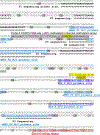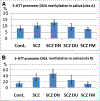DNA hypermethylation of serotonin transporter gene promoter in drug naïve patients with schizophrenia
- PMID: 24411530
- PMCID: PMC7863587
- DOI: 10.1016/j.schres.2013.12.007
DNA hypermethylation of serotonin transporter gene promoter in drug naïve patients with schizophrenia
Abstract
Introduction: Dysfunctional serotonin signaling has been linked to the pathogenesis of autism, obsessive compulsive disorder, mood disorders and schizophrenia. While the hypo-activity of serotonin signaling is involved in the pathogenesis of depression, anxiety and obsessive compulsive disorder; LSD, an agonist of serotonin type 2 receptor (5-HTR2A) induces psychosis. Therefore, anxiety and depressive disorders are treated by SSRIs which inhibit serotonin transporter (5-HTT) while psychotic disorders are controlled by drugs that block serotonin and/or dopamine receptors. Since genetic polymorphisms and epigenetic dysregulation of 5-HTT are involved in the pathogenesis of mental diseases, we analyzed DNA methylation of 5-HTT promoter in post-mortem brains and saliva samples of patients with schizophrenia (SCZ) and bipolar disorder (BD) to evaluate its potential application as a diagnostic and/or therapeutic biomarker in SCZ and BD.
Methods: Whole genome DNA methylation profiling was performed for a total of 24 samples (including two saliva samples) using the Illumina 27K (for 12 samples) and 450K DNA methylation array platform (for another 12 samples), followed by bisulfite sequencing to identify candidate CpGs for further analysis. Quantitative methylation specific PCR (qMSP) was used to assess the degree of CpG methylation of 5-HTT promoter in 105 post-mortem brains (35 controls, 35 SCZ and 35 BD) and 100 saliva samples (30 controls, 30 SCZ, 20 BD and 20 first degree relatives of SCZ or BD). The U133 2.0 Plus Human Transcriptome array for a total of 30 post-mortem brain samples (each group 10) followed by quantitative real-time PCR was used to study 5-HTT expression in 105 post-mortem brain samples.
Results: The qMSP analysis for 5-HTT promoter region showed DNA hypermethylation in post-mortem brain samples of SCZ patients (~30%), particularly in drug free patients (~60%, p=0.04). Similarly, there was a trend for DNA hypermethylation in antipsychotic free BD patients (~50%, p=0.066). qMSP analysis of DNA extracted from the saliva samples also exhibited hypermethylation of 5-HTT promoter in patients with SCZ (~30%, p=0.039), which was more significant in drug naïve SCZ patients (>50%, p=0.0025). However, the difference was not significant between the controls and unaffected first degree relatives of patients with SCZ (p=0.37) and versus patients using antipsychotic drugs (p=0.2). The whole genome transcriptome analysis of post-mortem brain samples showed reduced expression of 5-HTT in SCZ compared to the control subjects (~50%, p=0.008), confirmed by quantitative real-time PCR analysis (~40%, p=0.035) which was more significant in drug free SCZ patients (~70%, p=0.022).
Conclusion: A correlation between reduction in 5-HTT expression and DNA hypermethylation of the 5-HTT promoter in drug naïve SCZ patients suggests that an epigenetically defined hypo-activity of 5-HTT may be linked to SCZ pathogenesis. Furthermore, this epigenetic mark in DNA extracted from saliva can be considered as one of the key determinants in a panel of diagnostic and/or therapeutic biomarkers for SCZ.
Keywords: Brain; DNA methylation; Saliva; Schizophrenia; Serotonin transporter.
Copyright © 2013 Elsevier B.V. All rights reserved.
Figures




References
-
- Abdolmaleky HM, Faraone SV, Glatt SJ and Tsuang MT., 2004. Meta-analysis of Association Between the T102C Polymorphism of the 5HT2a Receptor Gene and Schizophrenia. Schizophrenia Res, 67(1) 53–62. - PubMed
-
- Abdolmaleky HM, Cheng KH, Faraone SV, Wilcox M, Glatt SJ, Gao F, Smith CL, Shafa R, Aleali B, Carnevale J, Pan H, Papageorgis P, Ponte JF, Sivaraman V, Tsuang MT, Thiagalingam S., 2006. Hypomethylation of MB-COMT Promoter is a Major Risk Factor for Schizophrenia and Bipolar Disorder, Hum Mol Genet. 15(21) 3132–45. - PMC - PubMed
-
- Abdolmaleky HM, Smith CL, Zhou JR, Thiagalingam S (2008). Epigenetic alterations of the dopaminergic system in major psychiatric disorders. Methods Mol Biol. 448:187–212. - PubMed
-
- Abdolmaleky HM, Yaqubi S, Papageorgis P, Lambert AW, Ozturk S, Sivaraman V, Thiagalingam S., 2011. Epigenetic dysregulation of HTR2A in the brain of patients with schizophrenia and bipolar disorder. Schizophr Res. 129(2–3) 183–90. - PubMed
Publication types
MeSH terms
Substances
Grants and funding
LinkOut - more resources
Full Text Sources
Other Literature Sources
Medical

